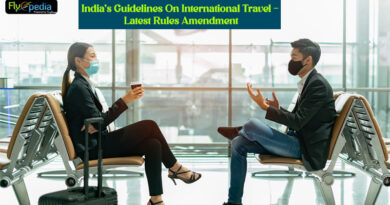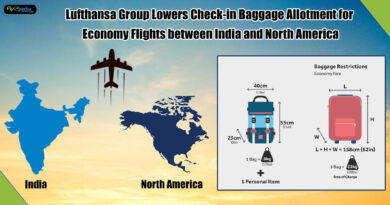A Complete Travel Guide to India’s Iconic Chhatrapati Shivaji International Airport
If you visit India, it’s extremely possible that you would land at Chhatrapati Shivaji International Airport in Mumbai. It is the country’s second busiest airport after Delhi, and it is a massive one at that. So, before you travel to Mumbai’s famed and beautiful ‘T2’ (terminal) with the best flight tickets to India, learn everything you need to know about Mumbai’s international airport to help you navigate better! If you’re on a voyage to Mumbai’s mesmerizing culture, city life & vibrancy then you should also check out the top things to keep in mind while traveling to Mumbai.
Its services are provided to the Mumbai Metropolitan Area in India. As a result of its enormous popularity, we are sharing a few intriguing facts about Mumbai Airport that some frequent passengers may be unaware of.
Chhatrapati Shivaji Maharaj International Airport (IATA: BOM, ICAO: VABB) serves Mumbai and the Mumbai Metropolitan Region (MMR). In terms of total and international passenger traffic, it is the country’s second busiest airport after Delhi, and it was the 14th busiest airport in Asia and the 41st busiest airport in the world in the calendar year 2019. 2018, it had around 49.8 million passengers who are always looking for the best flights deals. In March 2017, the airport surpassed London’s Gatwick Airport as the busiest single-runway airport in the world. This was eventually exceeded by Gatwick Airport at the end of 2019 when passenger counts in Mumbai fell.
It has two operational terminals situated across a total land area of 750 hectares (1,850 acres) and handles around 950 aircraft movements each day. It handled a record 1,007 aircraft movements on December 9, 2018, breaking its previous record of 1,003 flight movements in a day set in June 2018. On September 16, 2014, it handled a record 51 moves in one hour. Airports Council International named it, together with IGI Delhi, the “World’s Best Airport” at the Airport Service Quality Awards 2017 in the highest category of airports handling more than 40 million passengers yearly. It was also named “Best Airport in India and Central Asia” at the Skytrax 2016 World Airport Awards.
It is one of three airports in India that have utilized Airport Collaborative Decision Making (A-CDM) to ensure timely takeoffs and landings. In the fiscal year 2020, Mumbai Airport handled 45.87 million passengers, trailing only IGI’s 67.3 million in India.
History of Chhatrapati Shivaji International Airport

The ‘Juhu Aerodrome’ was India’s and Bombay’s (now Mumbai) first airport, completed in 1932. In the initial stages, the airport, less than 2 kilometers from the actual site of Chhatrapati Shivaji Maharaj International Airport (CSMIA), was utilized by postal delivery planes. However, in 1940, authorities decided to relocate and selected Santa Cruz as the new location for Chhatrapati Shivaji Airport.
After serving as a base for the British Royal Air Force during World War II, Mumbai Airport came under the management of the Directorate General of Civil Aviation post-independence, and a new terminal was inaugurated in 1958.
The International Airports Authority of India assumed control of Mumbai’s Chhatrapati Shivaji International Airport (BOM) in 1972, leading to the completion of development plans over the next three decades.
By the turn of the millennium, the airport had developed to become one of the busiest in India and the globe for passengers booking flight tickets to India.
Ownership
A consortium comprised of GVK Industries Ltd, Airports Company South Africa, and Bidvest secured the contract to manage and operate Chhatrapati Shivaji Maharaj International Airport (CSMIA). To execute this mission, Mumbai International Airport Private Limited (MIAL) was established as a joint venture, with the consortium holding a 74% stake and the Airports Authority of India holding the remaining 26%. MIAL has made significant upgrades to the aesthetics, design, and passenger amenities at CSIA since then, including the refurbishing of domestic terminals 1A and 1B, international terminals 2B and 2C for travelers booking direct flight tickets to Mumbai, and the inauguration of a completely new domestic terminal 1C and Terminal T2. Also MIAL worked on airside improvements such as the installation of new taxiways and aprons, as well as the restoration of both runways.
MIAL entered into an arrangement with Air Transport IT expert SITA in February 2008, resulting in CSIA becoming the first airport in India to implement common-use self-service kiosks and CUTE (Common Use Terminal Equipment) check-in systems.
Interesting facts about Chhatrapati Shivaji International airport:
When it comes to learning about your preferred airline or airport, people are eager to learn the little-known facts about it.
- Sahar International Airport is another name for Chhatrapati Shivaji International Airport.
- In terms of overall foreign passenger traffic, the airport is the second busiest in the country. It is also the 14th busiest airport in Asia, as well as the 29th busiest airport in the globe.
- The Chhatrapati Shivaji International Airport was awarded the title of Best Airport in India and Central Asia at the Skytrax 2016 World Airport Awards. Airports Council International named it the ASQ Best Airport in the 25-40 million passenger per year category in 2015.
- Many airlines provide the best flights deals and use Mumbai Airport as their main hub. This comprises Air India, SpiceJet, Jet Airways, GoAir, Blue Dart Aviation, Jetconnect, and IndiGo.
- The Mumbai Airport’s Terminal T2 cost a hefty Rs. 12,500 crores to build.
- The art project at Mumbai Airport is the world’s largest, with over 6,000 pieces of art in total.
- The airport’s name is a tribute to the 17th-century Maratha Emperor Chhatrapati Shivaji. The airport was formerly named Chhatrapati Shivaji International Airport, but on December 8, 2016, the Maharashtra government changed it to Chhatrapati Shivaji Maharaj International Airport, adding “Maharaj” to the name.
State-of-the-art exhibitions
The museum with Indian art on the walls is one of the most stunning aspects of the international airport. The walk may be rather lengthy, but they’ve made sure there’s enough to look at, and the roof, inspired by dancing peacocks, is also a sight to behold. Everyone in the airport has access to free wireless internet, and attendants are constantly on hand or on call to assist travelers with specific requirements. Wheelchairs, slots, ramps, and elevators are available at the airport.
The international airport becomes fairly busy at night so plan your route there properly. Once there, you are certain to meet several mosquitoes. So, taking some ointments to keep them from biting the daylights out of you will be a smart idea. While there are several hotels in the airport, there are no retiring rooms inside the airport. However, for transit travelers, there are several lounges that are fairly pleasant if you want to grab a snooze and not worry about your bags. These lounge spaces offer a variety of facilities for travelers arriving by flight tickets to India such as a library, massage, food, alcoholic drinks, and infant care rooms.
FAQ
Q. Where exactly is Mumbai Airport?
A. CSIA runs domestic carriers SpiceJet, IndiGo, and GoAir out of Terminal 1 in Santacruz (E), Mumbai, and Vistara, AirIndia, and Jet Airways out of Terminal 2 in Sahar, Andheri (E), Mumbai. Terminal 2 is where all international operations take place.
Q. To how many cities does Mumbai Airport provide service?
A. As of April 2017, 44 passenger airlines and 15 freight carriers served a total of 47 overseas destinations. Domestically, 7 separate passenger airlines and 1 freight airline serve a total of 47 domestic destinations.
Q. What are the normal processes to follow upon landing in Mumbai?
A. International travelers – All passengers traveling internationally must clear immigration and customs upon arrival. Both immigration and customs have their own checkpoints.
All travelers of foreign nationality arriving in Mumbai must fill out an arrival card and give it to the immigration office along with a valid passport and visa. The requirement stipulates that the passport must be valid for a minimum of 6 months.
All Indian nationals coming to Mumbai must clear immigration by producing appropriate travel documentation, such as a passport and a visa.
Passengers may pick up their individual baggage/s from the baggage hall and proceed to the arrival exit after clearing immigration and customs.
Domestic travelers may collect their baggage/s from the baggage area and continue to the arrival exit upon arrival.



